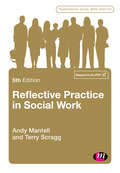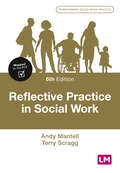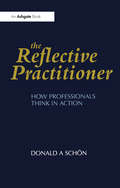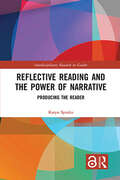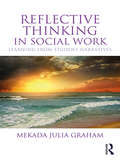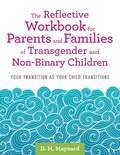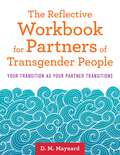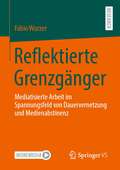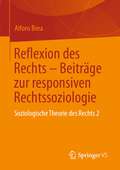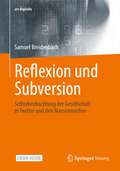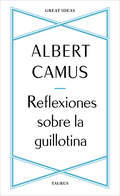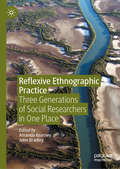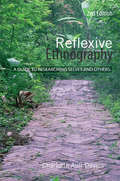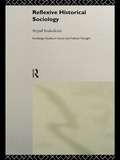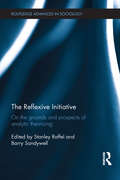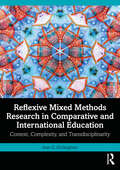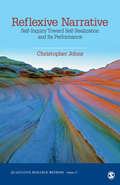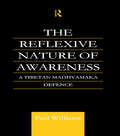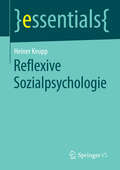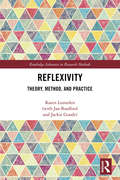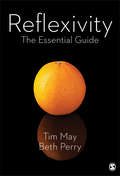- Table View
- List View
Reflective Practice in Social Work (Transforming Social Work Practice Series)
by Andy Mantell Mr Terry ScraggReflective practice is at the heart of becoming a competent and confident social worker. It's both a key element of learning and development on social work courses and an important aspect of social work practice. This accessible and introductory text explores a range of approaches to reflective practice to help students become more confident in answering key questions, including 'what is reflective practice?', 'how do I develop as a reflective practitioner?' and 'how do I maintain reflective practice in key contexts?'. There are many useful resources such as Writing reflective journals, Communicating well with service users and carers and Reflective practice while on placements.
Reflective Practice in Social Work (Transforming Social Work Practice Series)
by Andy Mantell Terry ScraggReflective practice is at the heart of becoming a competent and confident social worker. It’s both a key element of learning and development on social work courses and an important aspect of social work practice. This accessible and introductory text explores a range of approaches to reflective practice, its main aim being to help you as a student become more confident in answering key questions, including ′what is reflective practice?′, ‘how do I develop as a reflective practitioner?’, ‘how do I maintain reflective practice in key contexts?’. There are sections on writing reflective journals, communicating well with service users and carers and reflective practice while on placements.
Reflective Practice in Social Work (Transforming Social Work Practice Series)
by Andy Mantell Terry ScraggReflective practice is at the heart of becoming a competent and confident social worker. It’s both a key element of learning and development on social work courses and an important aspect of social work practice. This accessible and introductory text explores a range of approaches to reflective practice, its main aim being to help you as a student become more confident in answering key questions, including ′what is reflective practice?′, ‘how do I develop as a reflective practitioner?’, ‘how do I maintain reflective practice in key contexts?’. There are sections on writing reflective journals, communicating well with service users and carers and reflective practice while on placements.
The Reflective Practitioner: How Professionals Think in Action
by Donald A. SchönA leading M.I.T. social scientist and consultant examines five professions - engineering, architecture, management, psychotherapy, and town planning - to show how professionals really go about solving problems. The best professionals, Donald Schön maintains, know more than they can put into words. To meet the challenges of their work, they rely less on formulas learned in graduate school than on the kind of improvisation learned in practice. This unarticulated, largely unexamined process is the subject of Schön's provocatively original book, an effort to show precisely how 'reflection-in-action' works and how this vital creativity might be fostered in future professionals.
Reflective Reading and the Power of Narrative: Producing the Reader (Interdisciplinary Research in Gender)
by Karyn SprolesReflective Reading and the Power of Narrative: Producing the Reader is an interdisciplinary exploration into the profound power of narratives to create—and recreate—how we imagine ourselves. It posits that the process of producing a text also produces the reader. Written from the perspective of a psychoanalytic feminist, Sproles considers a wide array of examples from literature, popular culture, and her own experiences to illustrate what she calls "reflective reading"—a metacognitive reading practice that recognizes the workings of the unconscious to push the reader toward a potentially transformational engagement with narrative. This may manifest as epiphany, recovery from loss or resolution of repressed trauma. Each chapter draws on examples of characters and authors who model a reflective reading process from Jane Austen and Virginia Woolf to Johnny Cash and Alison Bechdel. By reclaiming the role of the unconscious, Karyn Sproles reinvigorates the theoretical work begun by reader-response criticism and develops a deep understanding of identification and transference as an integral part of the reading process. For students and researchers of cultural studies, psychoanalysis, gender studies and feminist literature and theory, Reflective Reading and the Power of Narrative offers innovative and accessible ideas on the relationship between reader and text.
Reflective Thinking in Social Work: Learning from student narratives
by Mekada Julia GrahamIt is vital that social work students learn to integrate their personal and professional selves if they are to meet the challenges of social work in complex changing environments. This accessible text is designed to enable readers to explore and build on their existing skills and abilities, supporting them to become competent and self-aware reflective practitioners. Reflective Thinking in Social Work uses stories told by a range of social work students to model reflective practice learning. Discussing issues such as identity, motivation to enter the social work profession and lived experiences in the journey into social work, the book brings together stories of hardship, privilege, families, hopes, interests and community activism from many diverse ethnic backgrounds. Each narrative is introduced by the author and ends with a commentary drawing out the key themes and exploring how the reader can use the narrative to enhance their own understanding and critical thinking, and to engage in transformative practice. Framed by an in-depth discussion of available frameworks for reflective practice in different contexts and the importance of narratives in constructing identities, this is an invaluable text for social work students at both bachelor's and master's degree levels.
The Reflective Workbook for Parents and Families of Transgender and Non-Binary Children: Your Transition as Your Child Transitions
by D. M. MaynardWhen a child goes through transition, the dynamics of the family unit can start to shift. It is not uncommon for one family member to feel one way about the transition, while another may feel quite differently. This innovative workbook discusses the unique needs of parents and families as they navigate their child's gender exploration. Providing a safe space for them to work through their own uncertainties and necessities, it gives specifically tailored guidance and support, with sections on school life, language and terminology, finding a therapist, possible grief, social/medical intervention options and more. Personal anecdotes from parents and other family members offer insight and understanding, alongside reflective activities, quizzes and positive affirmations throughout.
The Reflective Workbook for Partners of Transgender People: Your Transition as Your Partner Transitions
by D. M. MaynardPartners of people in transition go through their own transitions and may or may not be conflicted as to whether they will remain in their relationship. This unique self-help workbook was created for and focuses on the partner's perspective and own journey. By providing the support and structure needed for partners to reflect, this resource helps navigate the unexpected transition that affects both of their lives. Providing an essential tool that is currently missing, this book gives guidance and advice specifically designed for this situation, alongside activities, quizzes, and personal anecdotes. By combining portions of the author's self-exploration-as the partner of someone who began to transition after 17 years of being in their relationship- with the experiences shared by those who attended her workshops, this workbook examines the challenges, uncertainties, and possible grieving some partners experience throughout the transition process. With space for responding to reflective questions, exercises and games, this workbook offers partners a safe haven to discover their own wants and needs and will be of interest to both couples and individual counselors.
Reflektierte Grenzgänger: Mediatisierte Arbeit im Spannungsfeld von Dauervernetzung und Medienabstinenz
by Fabio WurzerWie gestaltet sich für Pfarrpriester unter dem Einfluss der Nutzung von Technologien zur digitalen Vernetzung die Wahrnehmung von und der Umgang mit Raum, Zeit und sozialen Beziehungen? Diese Frage versucht der Autor in dieser empirischen Arbeit zu beantworten, indem er das Zusammenspiel zwischen der Nutzung digitaler Medien und der Anwendung sozialer Praktiken im Pfarralltag untersucht. Auf Grundlage der Daten konnte für die gegenständliche Studie der Idealtypus des Reflektierten Grenzgängers entwickelt werden. Dieser Idealtypus beschreibt einen Menschen, der nach einer reflektierten Gestaltung seiner Lebensbereiche Arbeit und Freizeit strebt, um nicht wie der Idealtypus des Effizienten Menschen ein Maximum an Aufgaben, sondern die jeweiligen Aufgaben bestmöglich zu bewältigen. Eine effiziente Mediennutzung und das Grenzmanagement sind folglich nur die Voraussetzungen, um in einer von digitalen Medien durchsetzten Welt bestmögliche Arbeit leisten zu können.
Reflexion des Rechts – Beiträge zur responsiven Rechtssoziologie: Soziologische Theorie des Rechts 2
by Alfons BoraDieses Buch versammelt Überlegungen zur Rechtssoziologie und zur soziologischen Rechtstheorie. Einzelstudien auf verschiedenen rechtssoziologischen Forschungsgebieten verdeutlichen die Möglichkeiten einer responsiven soziologischen Theorie des Rechts. Diese greift rechtstheoretische Fragen auf und macht sie soziologisch relevant. Die soziologische Theorie des Rechts verkörpert so die interdisziplinäre Integration von Autonomie und Praxis.
Reflexion und Subversion: Selbstbeobachtung der Gesellschaft in Twitter und den Massenmedien (ars digitalis)
by Samuel BreidenbachDie ehemals den Massenmedien vorbehaltene Funktion, die Gesellschaft zu reflektieren und diese gesellschaftlichen Selbstbeschreibungen auch gesellschaftsweit bekannt zu machen, kann heute auch von Social-Media-Plattformen erfüllt werden, wenn die Nutzer*innen dort die Gesellschaft beschreiben und diese Beiträge massenhaft verbreitet werden. Gleichzeitig unterscheiden sich die in den Social Media verbreiteten Gesellschaftsbeschreibungen enorm von jenen herkömmlicher Massenmedien – nicht zuletzt aufgrund der technischen Infrastrukturen der Plattformen. Aus Perspektive der sozialen Systemtheorie werden am Beispiel von Twitter Gemeinsamkeiten und Differenzen zwischen diesen beiden Formen gesellschaftlicher Selbstreflexion herausgearbeitet. Vor allem aber soll die Analyse die grundsätzlich divergenten Wirkungen aufzeigen, welche die (Selbst-)Reflexion der Gesellschaft nach sich ziehen kann, wenn diese einerseits gesellschaftliche Komplexität als einheitliche Realität greifbar macht und damit der Selbstvergewisserung dient, andererseits genauso die Kritik und das Hinterfragen des Bestehenden erlaubt.
Reflexiones sobre la guillotina
by Albert CamusEl breve pero gran ensayo del Nobel de Literatura, Albert Camus, contra la pena de muerte en Francia: uno de los textos más poderosos y persuasivos jamás escrito contra este castigo. A lo largo de la historia, algunos libros han cambiado el mundo. Han transformado la manera en que nos vemos a nosotros mismos y a los demás. Han inspirado el debate, la discordia, la guerra y la revolución. Han iluminado, indignado, provocado y consolado. Han enriquecido vidas, y también las han destruido. Taurus publica las obras de los grandes pensadores, pioneros, radicales y visionarios cuyas ideas sacudieron la civilización y nos impulsaron a ser quienes somos. Este poderoso texto, uno de los más hermosos y persuasivos que escribió Albert Camus, sitúa el respeto a la vida humana por encima de la necesidad de cumplimiento de la ley. Sus argumentos contra la violencia de Estado y las penas ejemplares tienen plena vigencia hoy, y conforman una obra clave para entender el pensamiento ético del premio Nobel.
Reflexive Ethnographic Practice: Three Generations of Social Researchers in One Place
by John Bradley Amanda KearneyPutting the anthropological imagination under the spotlight, this book represents the experience of three generations of researchers, each of whom have long collaborated with the same Indigenous community over the course of their careers. In the context of a remote Indigenous Australian community in northern Australia, these researchers—anthropologists, an archeologist, a literary scholar, and an artist—encounter reflexivity and ethnographic practice through deeply personal and professionally revealing accounts of anthropological consciousness, relational encounters, and knowledge sharing. In six discrete chapters, the authors reveal the complexities that run through these relationships, considering how any one of us builds knowledge, shares knowledge, how we encounter different and new knowledge, and how well we are positioned to understand the lived experiences of others, whilst making ourselves fully available to personal change. At its core, this anthology is a meditation on learning and friendship across cultures.
Reflexive Ethnography: A Guide to Researching Selves and Others (The\asa Research Methods Ser.)
by Charlotte Aull DaviesReflexive Ethnography is a unique guide to ethnographic research for students of anthropology and related disciplines. It provides practical and comprehensive guidance to ethnographic research methods, but also encourages students to develop a critical understanding of the philosophical basis of ethnographic authority. Davies examines why reflexivity, at both personal and broader cultural levels, should be integrated into ethnographic research and discusses how this can be accomplished for a variety of research methods. This revised and updated second edition includes: a new chapter on internet-based research and ‘interethnography’ chapters on selection of topics and methods, data collection and analysis, and ethics and politics of research practical advice on writing up ethnographic study new and updated research examples. Postmodernist relativism can lead to an over-emphasis on reflexivity that denies the possibility of social research. Reflexive Ethnography utilises postmodernist insights – incorporation of different standpoints, exposure of the intellectual tyranny of meta-narratives – but proposes that reflexive ethnographic research be undertaken from a realist perspective. Reflexive Ethnography will help students to use and understand ethnographic research practices that fully incorporate reflexivity without abandoning claims to develop valid knowledge of social reality.
Reflexive Historical Sociology (Routledge Studies in Social and Political Thought #Vol. 22)
by Arpad SzakolczaiThis book reconstructs and brings together the work of a number of social and political theorists in order to gain new insight on the emergence and character of modern Western society. It examines the intersection point of social theory and historical sociology in a new theoretical approach called "reflexive historical sociology". There is analysis of the works of Max Weber, Michel Foucault, Norbert Elias, Eric Voegelin and a number of others. The book is divided into three parts. Part 1 examines the works of Eric Voegelin, Norbert Elias, Lewis Mumford and Franz Borkenau. Part 2 is concerned with the major conceptual tools such as experience, liminality, process, symbolisation, figuration, order, dramatisation and reflexivity, and themes such as the history of forms of thought, subjectivity, knowledge and closed space and regulated time. Finally, the book examines the most important insights of the thinkers discussed, concerning the historical processes that led to modernity.
The Reflexive Initiative: On the Grounds and Prospects of Analytic Theorizing (Routledge Advances in Sociology)
by Barry Sandywell Stanley RaffelThe Reflexive Initiative is an authoritative intervention in the practice and tradition of reflexive social theory. It demonstrates the importance of the reflexive imperative, not only in the investigation of everyday life but across a wide range of human sciences and philosophical perspectives. Forty years after the publication of On the Beginning of Social Inquiry, the chapters in this collection range from re-appraisals of earlier essays on topics such as ‘reunions’, ‘rethinking art’ and ‘expats’ to contributions emphasising the opening of radical dialogues with other reflexive traditions and perspectives. These include psychoanalysis, Lacan, Hegel, Rene Girard, Daseinanalysis, dialectical method, critical feminism, and the dialogical tradition. In this dialogical spirit, the book contributes to the continuing project of analytic theorizing associated with the work of Alan Blum and Peter McHugh, and the recent turn to more ‘existential’ topics and politically engaged forms of reflexive research. It will be of particular use to students working in interpretive traditions of sociology, Critical theory, Postmodern thought and debates associated with reflexivity and dialectics in other disciplines and research programmes.
Reflexive Methodology: New Vistas for Qualitative Research
by Mats Alvesson Kaj SkoldbergPraise for the Second Edition: "In opposition to most literature on how to conduct good social science research which is either empirically oriented or gives priority to theoretical and philosophical considerations, which tends to make empirical research look odd or irrelevant, this volume on ′Reflexive Methodology′ explicitly turns towards a consideration of the perceptual, cognitive, theoretical, linguistic, political and cultural circumstances as backdrop of data interpretation and research design. It showed up to be the most important and informative resource and a source of enlightenment to my lecture on methodology at our institute. I can highly recommend the volume to lecturers and students alike." Professor Sabine Troeger, Geography Institute - Library, University of Bonn Reflexivity is an essential part of the research process. Mats Alvesson and Kaj Sköldberg make explicit the links between techniques used in empirical research and different research traditions, giving a theoretically informed approach to qualitative research. The authors provide balanced reviews and critiques of the major schools of grounded theory, ethnography, hermeneutics, critical theory, postmodernism and poststructuralism, discourse analysis, genealogy and feminism. Useful reading for students and researchers across the social sciences. The first edition established itself as a ground-breaking success, providing researchers with an invaluable guide to a central problem in research methodology - namely, how to put field research and interpretations in perspective, paying attention to the interpretive, political and rhetorical nature of empirical research. The second edition introduced a new chapter on positivism, social constructionism and critical realism, and offered new conclusions on the applications of methodology. This third edition of Reflexive Methodology provides further updates on new research, including neorealism, and illustrations and applications of reflexive methodology in formulating research strategies, that build on the acclaimed and successful previous editions
Reflexive Mixed Methods Research in Comparative and International Education: Context, Complexity, and Transdisciplinarity
by Joan G. DeJaeghereResponding to both the increase of mixed methods research (MMR) and the lack of dialogue about its philosophical and methodological practices in comparative and international education (CIE) Reflexive Mixed Methods Research in Comparative and International Education: Context, Complexity, and Transdisciplinarity offers readers an overview of different philosophical approaches to mixed methods, as well as the practical processes to engage in MMR with reflexivity.Comparing reflexivity to a kaleidoscope, the author describes how it can be used throughout the research process to engage with different paradigms and methods, as well as to integrate findings and consider emerging interconnections. The book discusses various ways to reflexively adapt designs, methods, and analyses, and integrate findings in MMR to better contextualize knowledge in the field of CIE. It illustrates different approaches to MMR through various case summaries, and each chapter poses reflexive questions for researchers to consider during their research projects. It emphasizes a critical realist approach, particularly for how it involves epistemological pluralism while also offering contingent explanations to educational questions. Through a reflexive approach, the book offers possibilities for conducting better and more epistemically just MMR.This is fascinating reading for both new and more experienced researchers to expand the craft of researching with MM. Interdisciplinary and transdisciplinary teams, as well as sole researchers, will find concrete research practices in the book for employing reflexive MMR to understand complex educational issues.
Reflexive Narrative: Self-Inquiry Toward Self-Realization and Its Performance (Qualitative Research Methods #57)
by Christopher JohnsReflexive Narrative: Self-Inquiry Toward Self-Realization and Its Performance is latest addition to the Qualitative Research Methods series. Author Christopher Johns describes this unique method and its developmental approach to research to enable researchers&’ self-realization however that might be expressed. This method focuses on systematizing the reflective process and providing structure while still remaining flexible to the needs of individual researchers and projects. Researchers collect data through reflections on everyday experiences and then selectively use the evidence of researcher&’s insights. The text starts out with a brief introduction to narrative research and reflexivity, situating the method within the larger context of organizational practices. The next chapters introduce the steps for reflexive narrative research and walk readers through the movements of the reflexive narrative process, writing, reflection, dialogue, guidance, weaving, and audiencing. Additional coverage of ethics and research examples provide a foundation for application of the method to individual research. A chapter on structuring the method for a doctoral thesis furthers the applied nature of this method. Three extracts from studies provide research examples across several social science disciplines, including nursing and education. For students and researchers alike looking for new approaches to reflexive methods and looking to expand their ideas about self-research in a qualitative context, Reflexive Narrative provides a starting place for their own examination of self in the context of research.
Reflexive Narrative: Self-Inquiry Toward Self-Realization and Its Performance (Qualitative Research Methods #57)
by Christopher JohnsReflexive Narrative: Self-Inquiry Toward Self-Realization and Its Performance is latest addition to the Qualitative Research Methods series. Author Christopher Johns describes this unique method and its developmental approach to research to enable researchers&’ self-realization however that might be expressed. This method focuses on systematizing the reflective process and providing structure while still remaining flexible to the needs of individual researchers and projects. Researchers collect data through reflections on everyday experiences and then selectively use the evidence of researcher&’s insights. The text starts out with a brief introduction to narrative research and reflexivity, situating the method within the larger context of organizational practices. The next chapters introduce the steps for reflexive narrative research and walk readers through the movements of the reflexive narrative process, writing, reflection, dialogue, guidance, weaving, and audiencing. Additional coverage of ethics and research examples provide a foundation for application of the method to individual research. A chapter on structuring the method for a doctoral thesis furthers the applied nature of this method. Three extracts from studies provide research examples across several social science disciplines, including nursing and education. For students and researchers alike looking for new approaches to reflexive methods and looking to expand their ideas about self-research in a qualitative context, Reflexive Narrative provides a starting place for their own examination of self in the context of research.
The Reflexive Nature of Awareness: A Tibetan Madhyamaka Defence (Routledge Critical Studies in Buddhism #Vol. 1)
by Paul WilliamsPlaces the controversy initiated by the Tibetan Tsong kha pa - who elaborated on one of the eight difficult points in understanding Madhyamaka philosophy - in its Indian and Tibetan context.
Reflexive Sozialpsychologie: Ambivalenzen Und Potenziale Eines Neuen Altersbildes In Der Flexiblen Arbeitswelt (essentials #8)
by Heiner KeuppDie neue Arbeitswelt ist von zunehmender Unsicherheit geprägt. Diskontinuierliche Beschäftigungsverhältnisse sind weiter auf dem Vormarsch. Für die Beschäftigten in der Wissensökonomie sind damit höhere Freiheitsgrade verbunden, aber auch neue Belastungen - bis hin zum Burnout. Zudem sind Jobnomaden, Freelancer und Zeitarbeitende oft von betrieblicher Gesundheitsförderung ausgeschlossen. Wie und von wem können diese Gruppen bei der Gesundheitsprävention unterstützt werden? Der Band beleuchtet diese Fragen aus verschiedenen sozialwissenschaftlichen Perspektiven und unterfüttert die Argumentation mit empirischen Erkenntnissen.
Reflexivity: Theory, Method, and Practice (Routledge Advances in Research Methods)
by Karen LumsdenReflexivity is valuable in social research because it draws attention to the researcher as part of the world being studied and reminds us that the individuals involved in our research are subjects, not objects. By being reflexive we acknowledge that we cannot be separated from our biographies. This volume reviews key debates concerning reflexivity in theory, methods, and practice. It mounts a defence of reflexivity against new materialist and post-qualitative critiques and the pressures exerted on scholars from the neoliberal marketized university system which privileges fast academia at the expense of slow, reflective scholarship. While defending reflexivity, this book also those identifies issues which plague mainstream sociological operationalizations of a positivistic form of reflexivity. It argues for the extension of reflexivity into domains otherwise neglected in public accounts, and a shift from reflexivity as an individualized quality of the researcher (used to judge peers and navel-gaze) to a feminist, collaborative, reflexive sensibility which is mindful of the wider contexts shaping the construction of knowledge(s), experience(s), and of the role of research communities. Providing examples of reflexivity in action from academics at different stages of their careers, Reflexivity will appeal to students and researchers interested in fields such as Sociology, Qualitative Research Methods, Criminology, Ethnography, and Ethics of Research.
Reflexivity: The Essential Guide
by Beth Perry Professor Tim MayReflexivity – the critical examination of how we see the world – is integral to good research practice. From this state-of-the-art, accessible tour of its history and contemporary relevance, readers will learn of its importance to social research and to society generally. The text introduces a host of influential thinkers and their key ideas on reflexivity, and incorporates examples from a range of disciplines and research settings. Drawing on the authors’ extensive experience of real research settings, this book: Pinpoints the importance of reflexivity in social research Demonstrates its relevance to everyday life Firmly locates the concept in the history of ideas Explores key questions about the bases of knowledge and understanding Presents key thinkers, concepts and issues in easy-to-understand learning boxes The result is a book that provides students and researchers in the social sciences with the knowledge and understanding necessary not only to examine the role of reflexivity in contemporary life, but to apply it in their own research practice.
Reflexivity: The Essential Guide
by Beth Perry Professor Tim MayReflexivity – the critical examination of how we see the world – is integral to good research practice. From this state-of-the-art, accessible tour of its history and contemporary relevance, readers will learn of its importance to social research and to society generally. The text introduces a host of influential thinkers and their key ideas on reflexivity, and incorporates examples from a range of disciplines and research settings. Drawing on the authors’ extensive experience of real research settings, this book: Pinpoints the importance of reflexivity in social research Demonstrates its relevance to everyday life Firmly locates the concept in the history of ideas Explores key questions about the bases of knowledge and understanding Presents key thinkers, concepts and issues in easy-to-understand learning boxes The result is a book that provides students and researchers in the social sciences with the knowledge and understanding necessary not only to examine the role of reflexivity in contemporary life, but to apply it in their own research practice.
